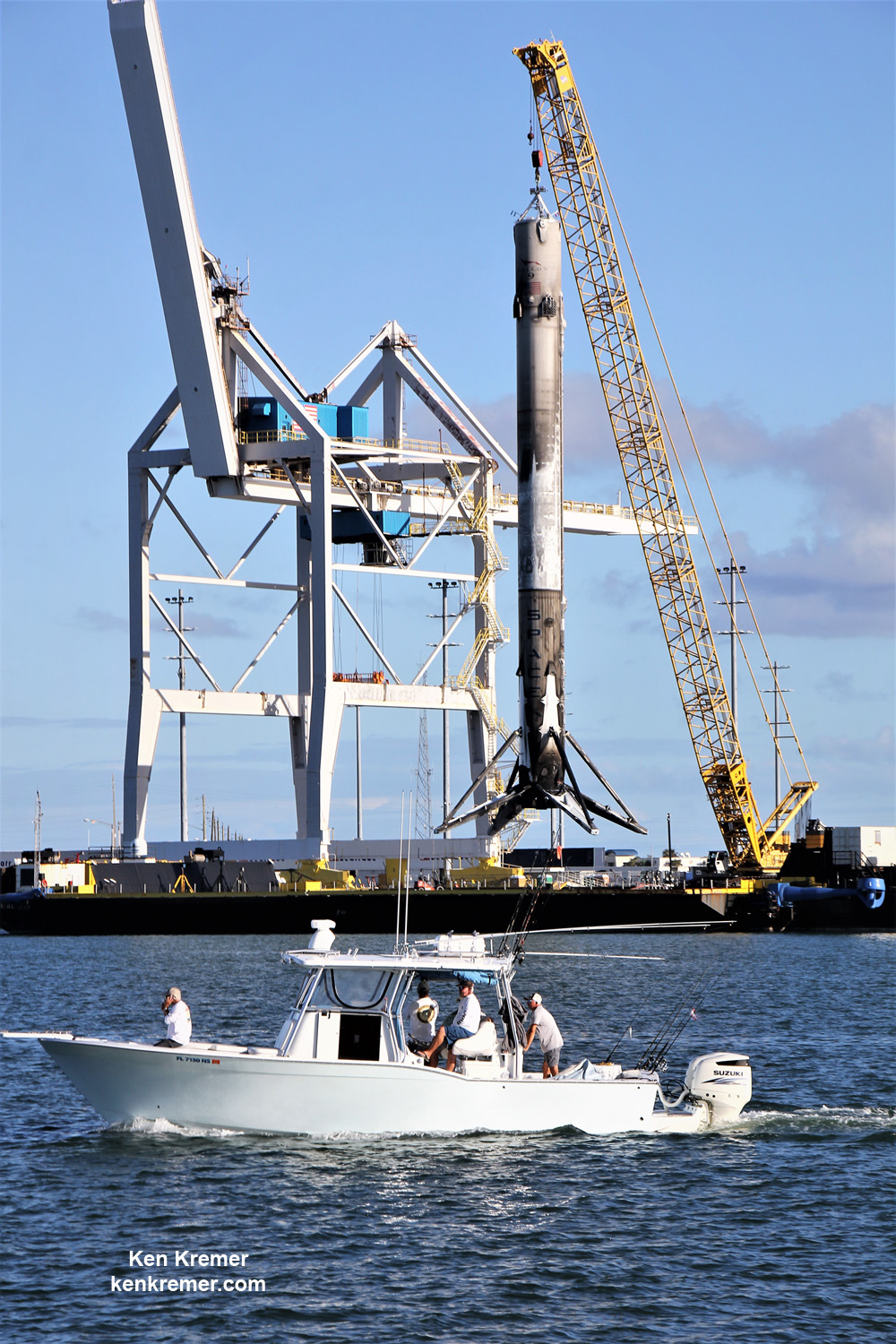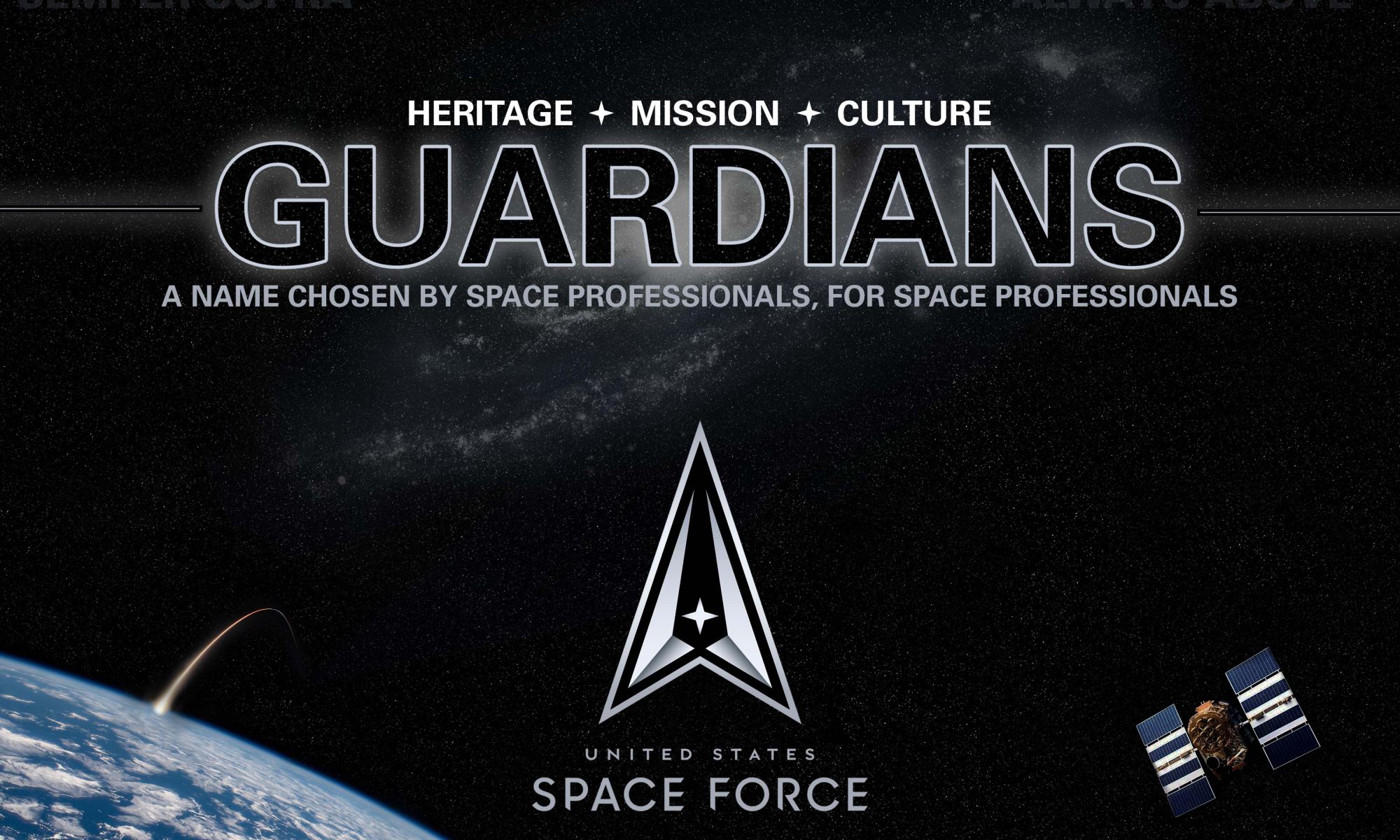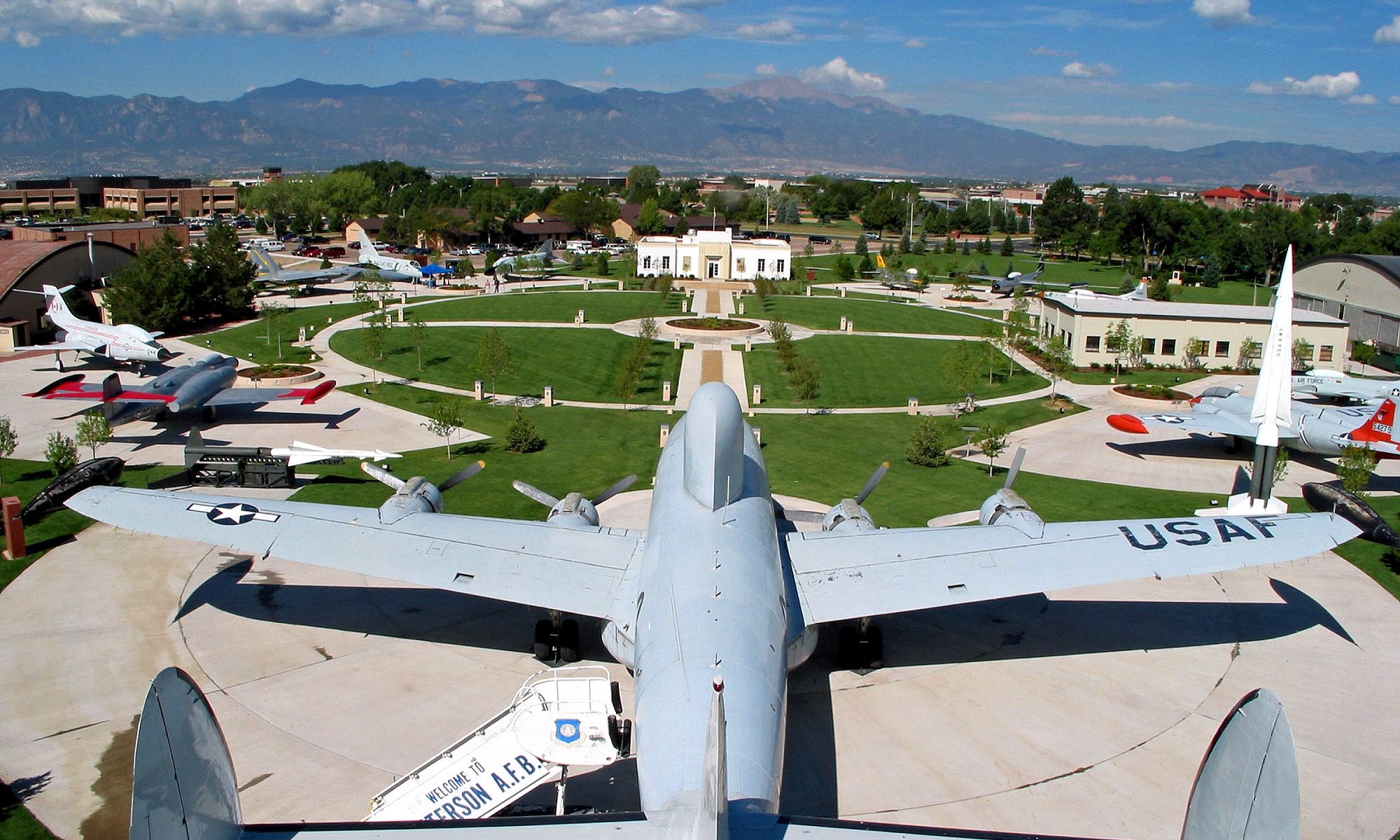The head of the Pentagon office that is reviewing reported unidentified anomalous phenomena (UAP – commonly known as UFOs, unidentified flying objects) told the US Congress this week that his office is now reviewing more than 650 incidents, but so far, none exhibited anything that was evidence of extraterrestrial activity or defied the known laws of physics.
Continue reading “UFO Office Fails to Find Anything That Defies the Laws of Physics”Falcon Heavy Launches for the First Time in Over Three Years, Carrying Military Satellites to Orbit

SpaceX launched its gigantic Falcon Heavy rocket for the first time in more than three years, sending satellites for the military to orbit. The rocket took off amid heavy fog at Kennedy Space Center on Tuesday, November 1, and a few minutes later two booster segments returned to Earth, sticking the side-by-side landings back at Cape Canaveral.
Continue reading “Falcon Heavy Launches for the First Time in Over Three Years, Carrying Military Satellites to Orbit”North Korea Releases Pictures of Earth They Say Were Taken From Space
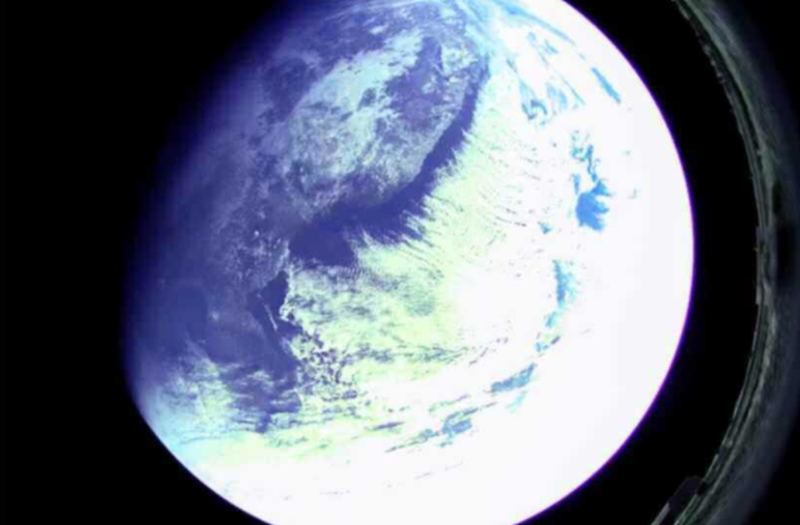
North Korea released some pictures they say come from their recent missile test. The missile they tested—the intermediate-range Hwasong-12—can reach the U.S. territory of Guam. According to most North Korea observers, the country hopes the tests will bring the U.S. back to the negotiating table.
Continue reading “North Korea Releases Pictures of Earth They Say Were Taken From Space”The Personnel of Space Force Will be Called Guardians
In October of 2018, the Trump administration announced the creation of the U.S. Space Force (USSF), previously known as the U.S. Air Force Space Command (AFSPC). The decision was formalized on December 20th, 2019, with the signing of the National Defense Authorization Act for 2020 (NDAA 2020). Since then, the USSF has taken steps to establish all the particulars of an independent service branch.
This included the creation of a logo and a motto (reminiscent of Starfleet and “Semper Supra!”), a headquarters, a recruiting video, and a training program. They even conducted their first joint mission with the USAF, sending the X-37B to space to test a number of technology demonstrators. And in honor of its one-year anniversary, the VP Pence announced that it has chosen what it will call USSF service members – Guardians!
Continue reading “The Personnel of Space Force Will be Called Guardians”U.S. Space Force is Looking For a Place to Put its Headquarters
In the past year, the newly-formed US Space Force has taken a number of steps to set itself apart as an independent service branch. This included adopting a logo, uniforms, a flag, specialized training for career tracks, a recruitment video, and conducting its first missions (like the recent launch of the X-37B). And now, they have announced that they have adopted a revised approach for locating a headquarters.
Previously, the US Space Force was to be headquartered at Peterson Air Force Base in Colorado Springs. The revised approach, instituted by the Department of the Air Force and the Office of Secretary of Defense, takes into account the emerging organizational structure of the USSF and the impact it will have. This move expands the number of possible locations for a permanent USSF base and an analysis process for choosing the final spot.
Continue reading “U.S. Space Force is Looking For a Place to Put its Headquarters”X-37B Lands After 780 Days in Orbit Doing ???
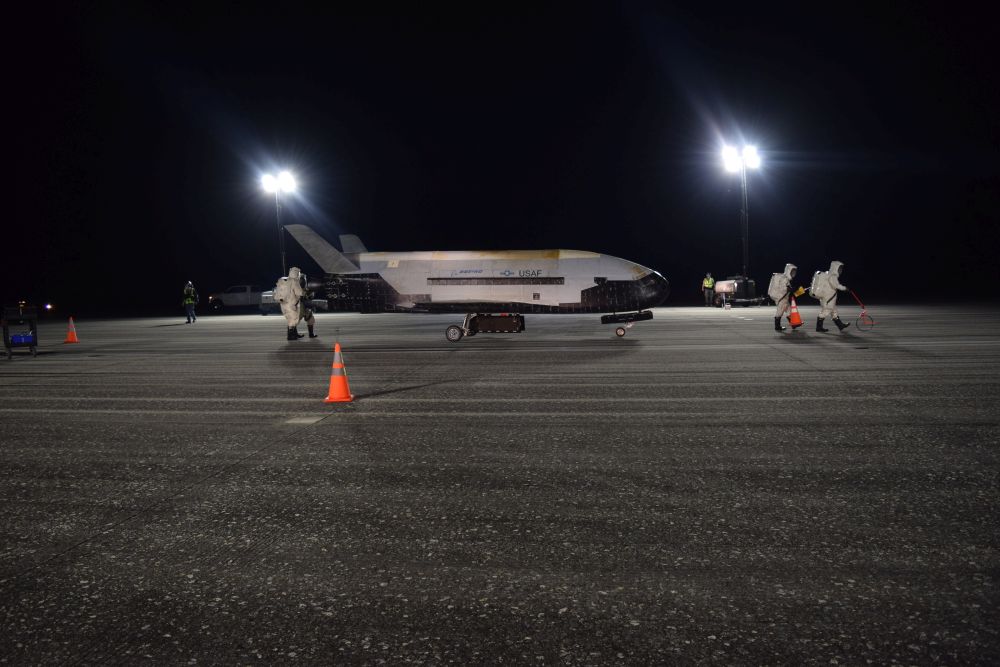
The X-37B, the US Air Force’s experimental, Orbital Test Vehicle (OTV) has come back down to Earth after 780 days. It landed at the Kennedy Space Center Shuttle Landing Facility on Oct. 27, 2019, at 3:51 a.m. after breaking its own record for time in space. The X-37B has now spent 2,865 total days in orbit.
The question is, what’s it doing up there?
Continue reading “X-37B Lands After 780 Days in Orbit Doing ???”SpaceX Resuming Launches from Damaged Pad 40 on Dec. 4 with Station Resupply Flight for NASA; Covert Zuma Remains on Hold
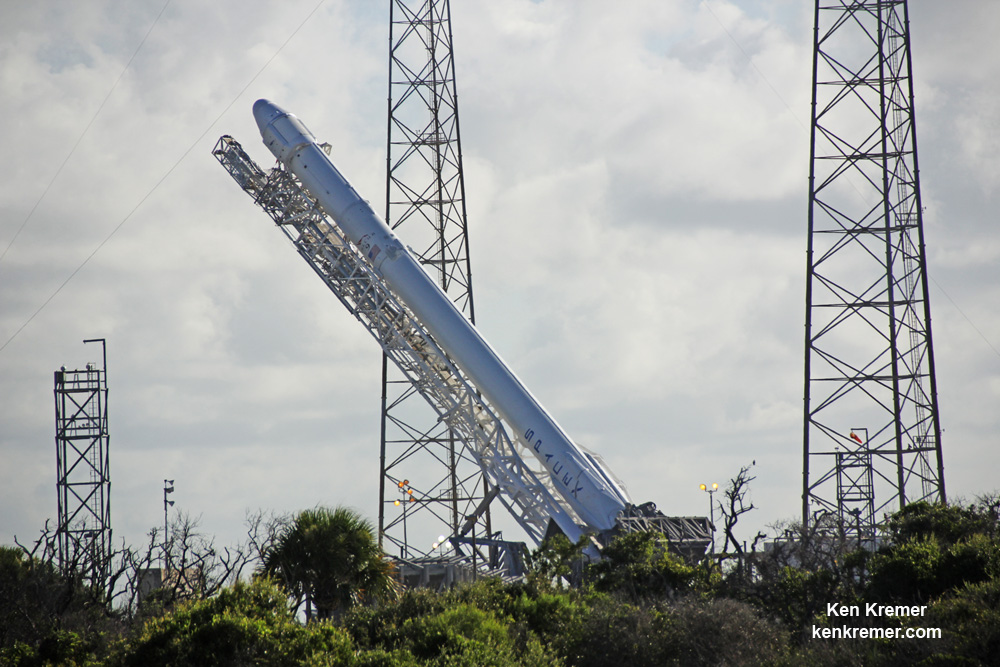

KENNEDY SPACE CENTER, FL – After postponing last week’s liftoff of the covert ‘Zuma’ spy satellite due to last minute concerns about the reliability of the payload fairing encapsulating it while poised for liftoff at KSC pad 39, SpaceX is set to at last resume launches from their previously damaged and now repaired Cape Canaveral pad 40 with a cargo resupply mission for NASA to the International Space Station (ISS) on Dec 4.
NASA and SpaceX have jointly decided to move forward with the Dragon CRS-13 cargo blastoff apparently because the mission does not involve use of the problematical payload fairing that halted last weeks planned Falcon 9 launch with the rocket and the mysterious Zuma payload.
Zuma was ready and waiting at pad 39A for the GO to launch that never came.
Then after a series of daily delays SpaceX ultimately announced a ‘stand down’ for super secret Zuma at pad 39A on Friday, Nov. 17, for the foreseeable future.
SpaceX engineers also had to deal with the after effects of a fire that broke out on a Merlin engine test stand during preparations for a hot fire test that resulted from a leak during a ‘LOX drop’ that halted testing of the Block 5 version of the Merlin 1D.
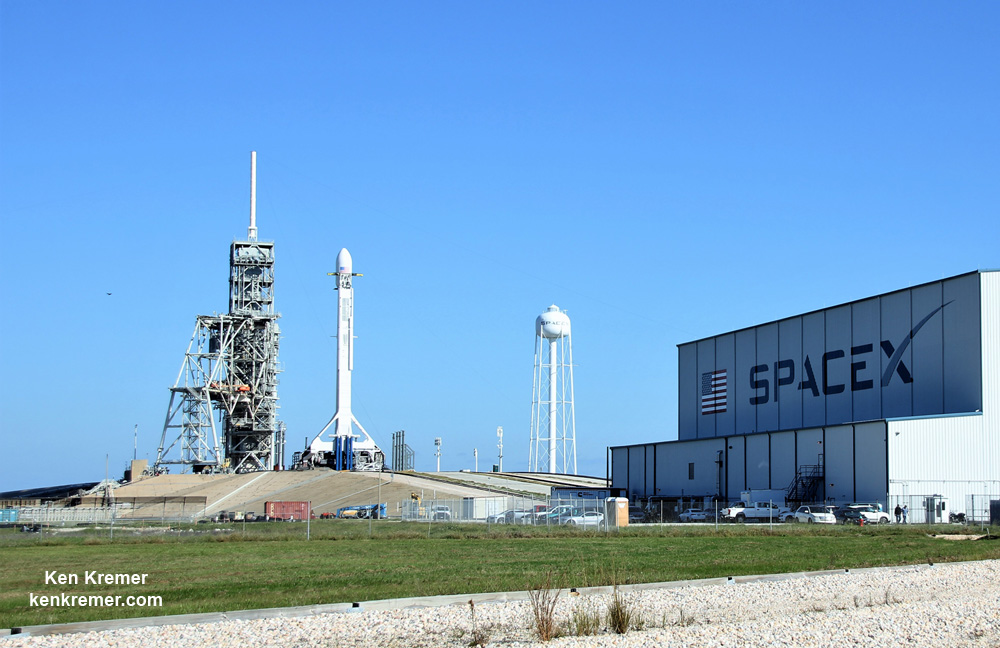
Since SpaceX’s gumdrop shaped Dragon cargo freighter launches as a stand alone aerodynamically shielded spacecraft atop the Falcon 9, it does not require additional protection from atmospheric forces and friction housed inside a nose cone during ascent to orbit unlike satellites with many unprotected exposed surfaces, critical hardware and delicate instruments.
Thus Dragon is deemed good to go since there currently appear to be no other unresolved technical issues with the Falcon 9 rocket.
“NASA commercial cargo provider SpaceX is targeting its 13th commercial resupply services mission to the International Space Station for no earlier than 2:53 p.m. EST Monday, Dec. 4,” NASA announced on the agency blog and social media accounts.
The Dec. 4 launch date for Dragon CRS-13 was announced by NASA’s space station manager Dan Hartman during the Orbital ATK Antares/Cygnus launch campaign that culminated with a successful blastoff last Sunday, Nov 12 from NASA’s Wallops Flight Facility on Virginia’s eastern shore.
But the targeted Dec 4 liftoff from Space Launch Complex 40 on Cape Canaveral Air Force Station, FL, was cast in doubt after SpaceX disclosed the payload fairing issue related launch delay on Friday.
Since last week SpaceX engineers have been busy taking the time to carefully scrutinize all the pertinent fairing data before proceeding with the top secret Zuma launch.
“We have decided to stand down and take a closer look at data from recent fairing testing for another customer,” said SpaceX spokesman John Taylor last Friday.
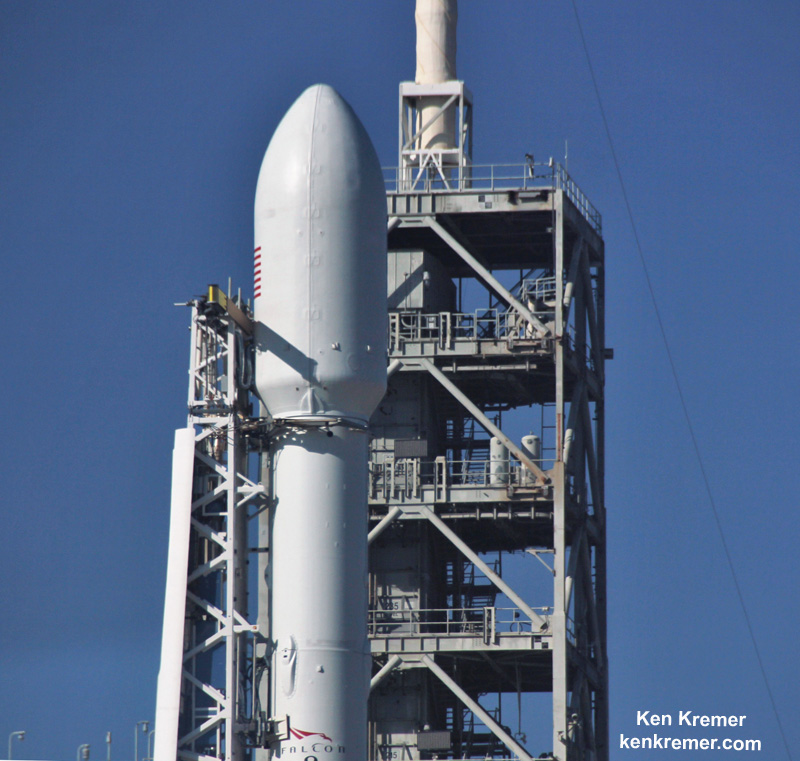
All of SpaceX’s launches this year from Florida’s Spaceport have taken place from NASA’s historic Launch Complex-39A at the Kennedy Space Center.
Pad 39A became SpaceX’s only operational Florida Space Coast launch pad following a catastrophic launch pad accident last year on Sept. 1, 2016 that took place during a routine fueling test that suddenly ended in a devastating explosion and fire that completely consumed the Falcon 9 rocket and Amos-6 payload and heavily damaged the pad and support infrastructure.

Since the Amos-6 accident workers raced to finish refurbishments to NASA’s long dormant pad 39A to transform into operational status and successfully launched a dozen missions this year.
Simultaneously additional crews have been hard at work to repair damaged pad 40 so that flights can resume there as soon as possible for the bulk of NASA, commercial and military contracted missions.
Meanwhile SpaceX wants to upgrade pad 39A to launch the Falcon Heavy and crewed Dragon flight. But those launches cant take place until pad 40 resumes operational status.
The Dragon CRS-13 mission was recently announced as the maiden mission for the reopening of pad 40.
Altogether Dragon CRS-13 will count as the fourth SpaceX Dragon liftoff of 2017.
The 20-foot high, 12-foot-diameter Dragon CRS-13 vessel will carry about 3 tons of science and supplies to the orbiting outpost and stay about 4 weeks.
It will be a reused Dragon that previously flew on the CRS-6 mission.
“The Dragon [CRS-13] spacecraft will spend about a month attached to the space station,” NASA said.
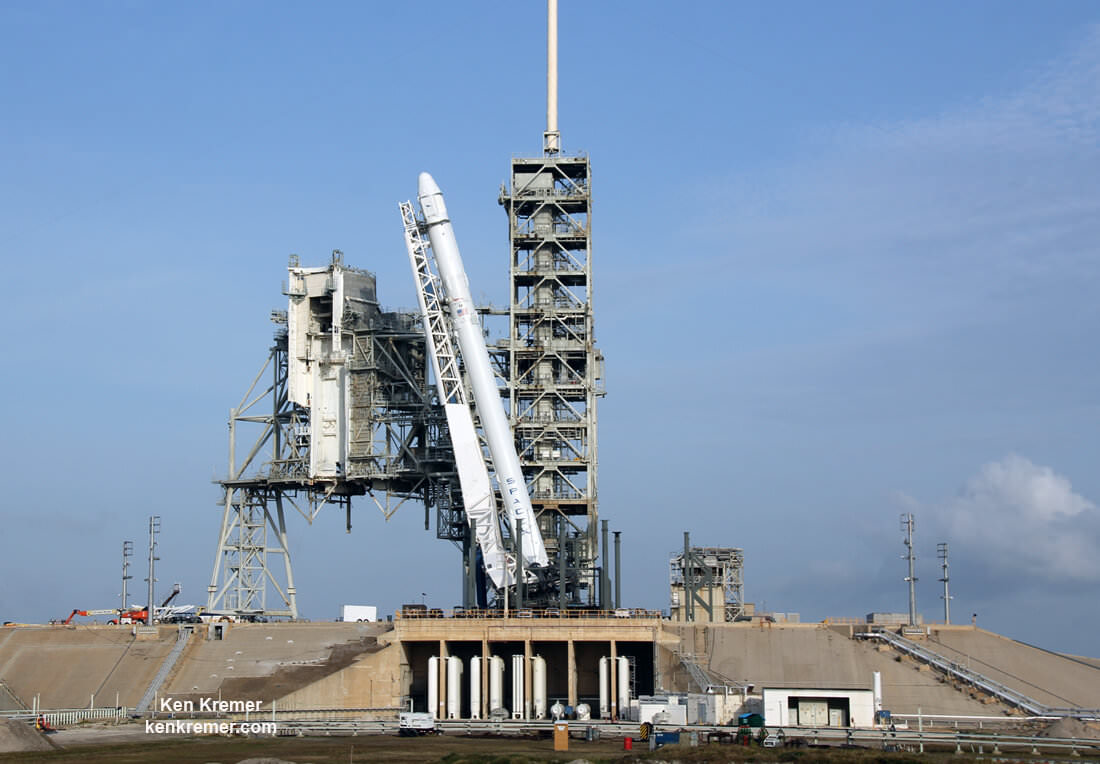
The prior Dragon CRS-12 resupply ship launched from pad 39A on Aug. 14, 2017 from KSC pad 39A and carried more than 6,400 pounds ( 2,900 kg) of science experiments and research instruments, crew supplies, food water, clothing, hardware, gear and spare parts to the million pound orbiting laboratory complex.
Dragon CRS-9 was the last ISS resupply mission to launch from pad 40 on July 18, 2016.
The recently arrived Orbital ATK Cygnus cargo ship is expected to depart the station from the Earth facing Unity node on Dec. 3 to make way for Dragon’s berthing at the Harmony node.
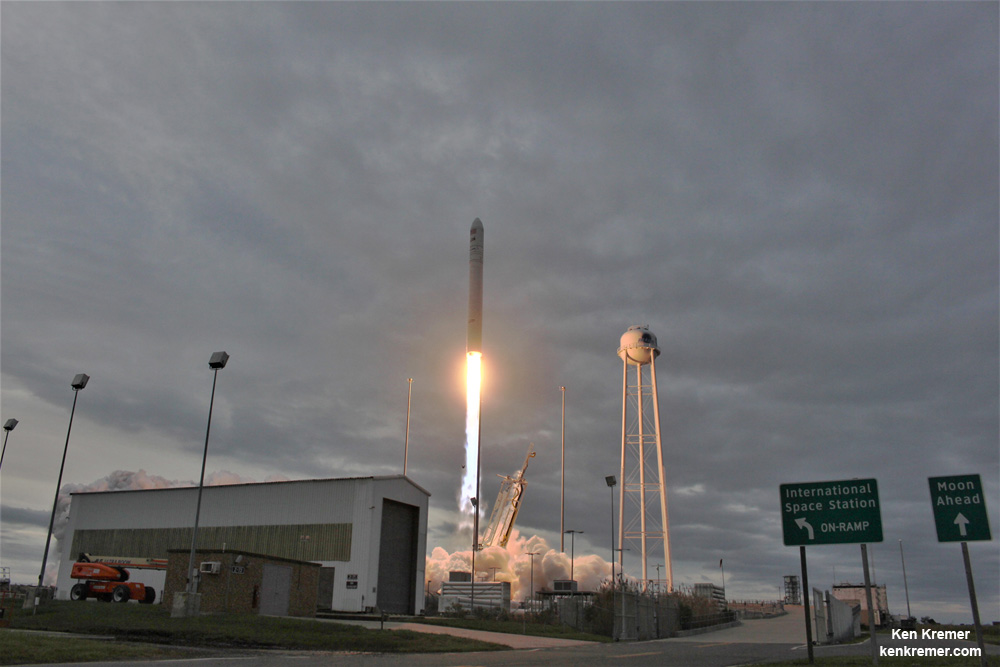
Watch for Ken’s continuing onsite coverage of SpaceX CRS-13, Zuma and KoreaSat-5A & Orbital ATK OA-8 Cygnus and NASA and space mission reports direct from the Kennedy Space Center and Cape Canaveral Air Force Station, Florida.
Stay tuned here for Ken’s continuing Earth and Planetary science and human spaceflight news.
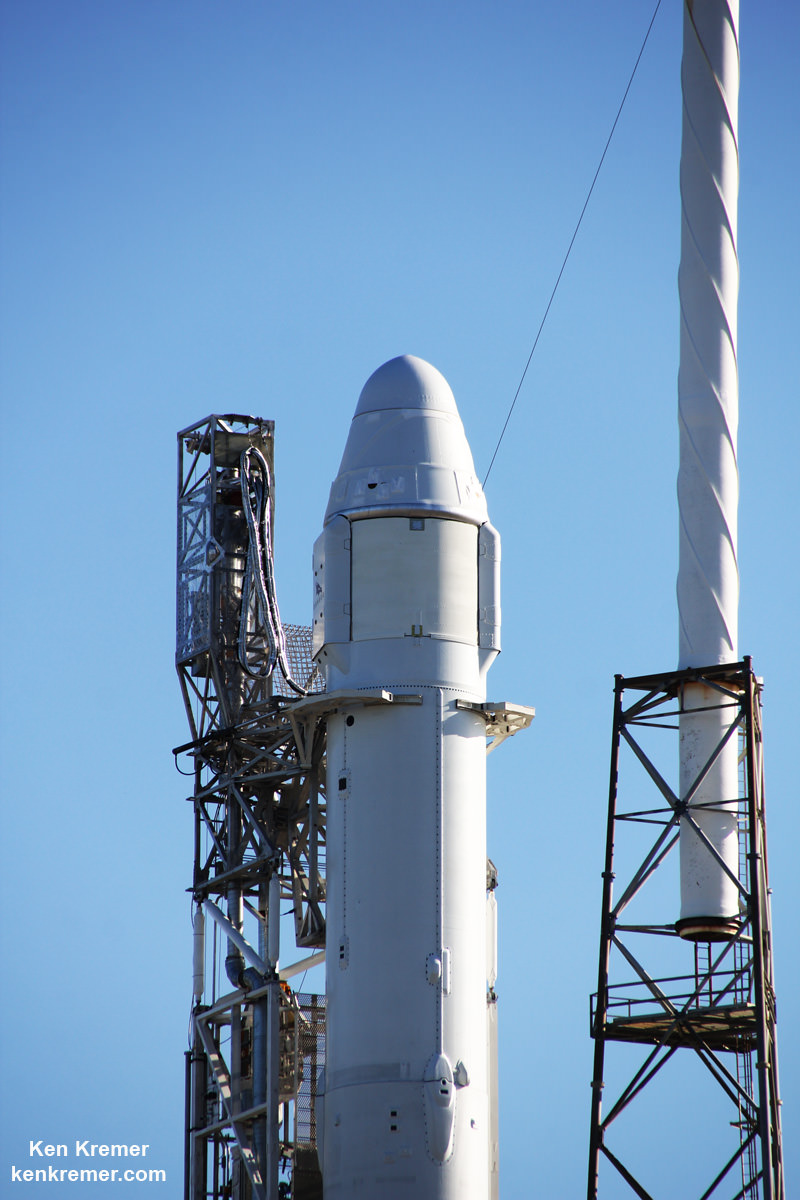

Clandestine Zuma SpySat’s SpaceX Liftoff Postponed Indefinitely to Resolve Payload Fairing Issue


KENNEDY SPACE CENTER, FL – Liftoff of the clandestine spy satellite codenamed ‘Zuma’ on a SpaceX Falcon 9 rocket has been postponed indefinitely to resolve a lingering issue with the testing of a payload fairing for another customer.
SpaceX announced today, Friday, Nov 17, that they will ‘stand down’ to allow engineers the additional time needed to carefully scrutinize all the pertinent data before proceeding with the top secret Zuma launch.
“We have decided to stand down and take a closer look at data from recent fairing testing for another customer,” said SpaceX spokesman John Taylor.
The super secret ‘Zuma’ spysat is a complete mystery and it has not been claimed by any U.S. government entity – not even the elusive NRO spy agency ! The NRO does claim ownership of a vast fleet of covert and hugely capable orbiting surveillance assets supporting US national security.
Zuma’s goals are veiled in virtually complete darkness. And as far as the taxpaying public is concerned its ownerless.
Originally scheduled for Wednesday evening at 8 p.m. EST Nov 15, the Zuma launch from the Florida Space Coast had already been postponed twice this week before today’s decision to called it off indefinitely.

The initial 24 hour delay to Thursday was to deal with unspecified ‘mission assurance’ issues.
The second days delay to Friday was pinned more specifically on the payload fairing or nose cone.
SpaceX has also had to deal with an engine testing problem that caused a fire on a test stand while preparing to hot fire a Block 5 Merlin 1D engine at their Texas facility on Nov. 4. It is not known if this was part of the ‘mission assurance’ issues.
No new targeted launch date has been announced.
“Though we have preserved the range opportunity for tomorrow, we will take the time we need to complete the data review and will then confirm a new launch date,” Taylor stated.
SpaceX had been planning an ambitious launch campaign of 4 or more launches by the end of this year – including the maiden launch of the triple barreled Falcon Heavy. That seems very unlikely now.
Just exactly what the fairing problem is has not been disclosed. Its also not known if the two delays are related or not.
The fairing is jettisoned three minutes after liftoff. Any failure to deploy would result in a total loss of the mission.
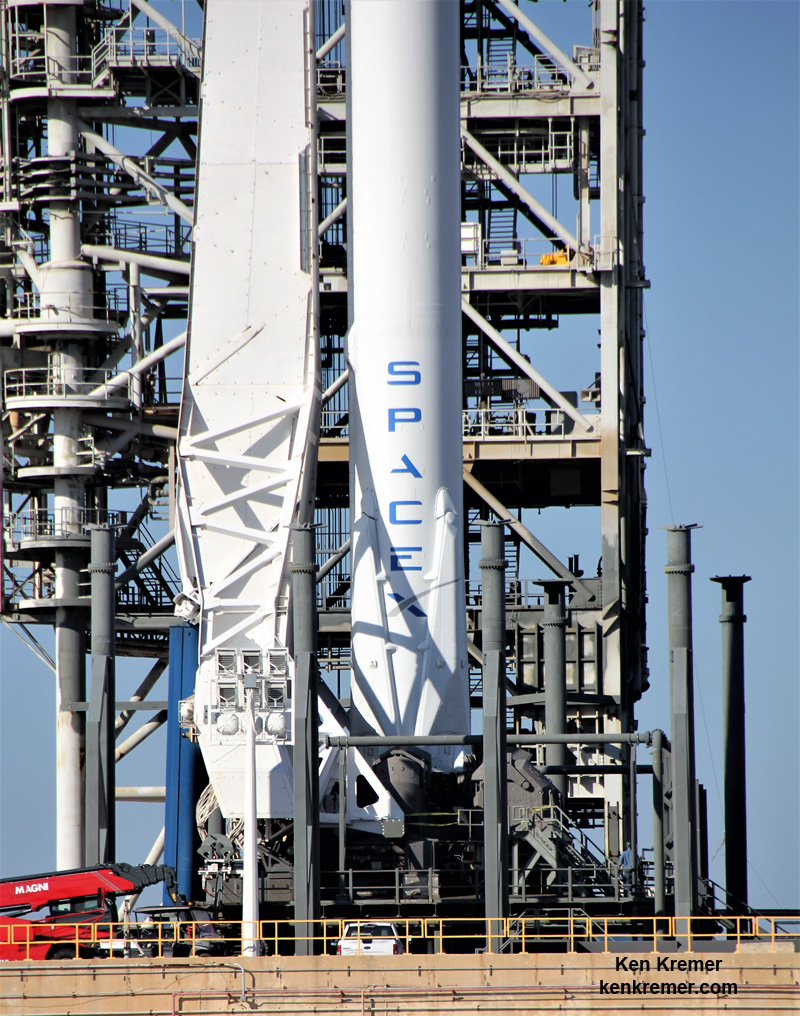
Zuma was to roar off seaside Launch Complex 39A at NASA’s Kennedy Space Center in Florida during a lengthy two hour launch window that extended from 8 to 10 p.m. each targeted day this week.
The Eastern range had been reserved by SpaceX for a potential Saturday launch opportunity as well.
However all mention of the Zuma launch has now been deleted from the website of the 45th Space Wing at Patrick Air Force Base, FL.
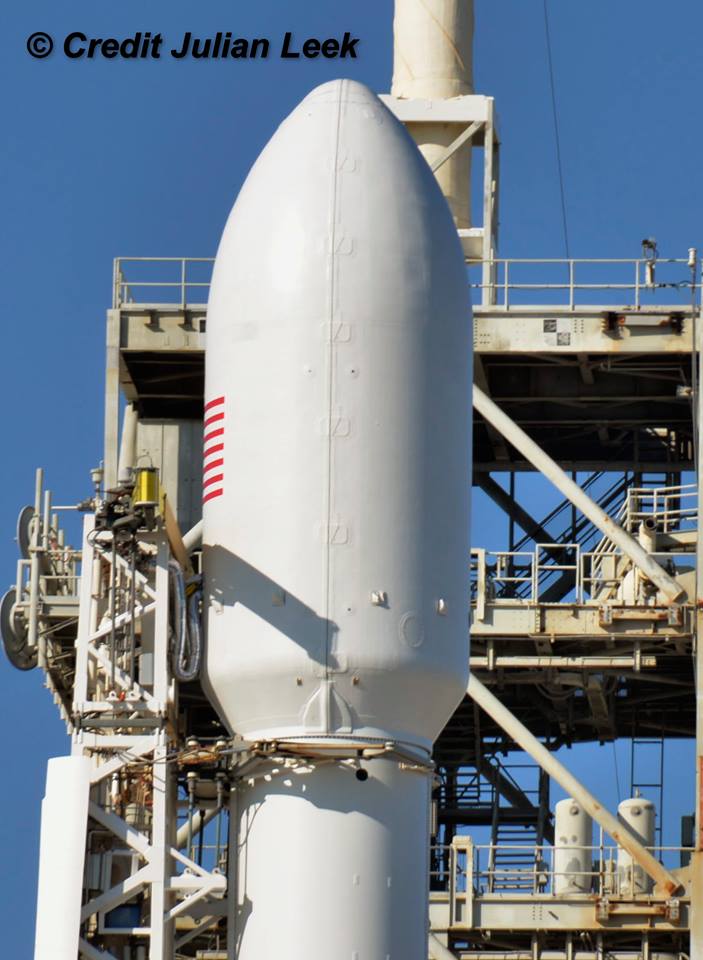
Forecast weather conditions in central Florida were near perfect over the past few days and spectators would have witnessed a dazzling sky show as the two stage 229-foot-tall (70-meter-tall) Falcon 9 soared to orbit.
One of the few tidbits we can confirm is that the launch contract was arranged as a commercial enterprise under the auspices of Northrop Grumman Corporation – as a means to significantly slash launch costs for whatever U.S government entity is responsible for Zuma.
That goal is completely in line with SpaceX founder and CEO Elon Musk’s entire company-wide goal in developing the Falcon and Dragon family of rockets and spaceships.
“The U.S. Government assigned Northrop Grumman the responsibility of acquiring launch services for this mission,” Lon Rains, Northrop Grumman Director of Communications, told Universe Today.
“We have procured the Falcon 9 launch service from SpaceX.”
But the launch was only publicly announced 1 month ago in mid October and it suddenly appeared on the SpaceX launch manifest after an FAA launch license was granted.
We don’t know anything about the ‘Zuma’ payloads characteristics and vital statistics – despite the seemingly endless leaks streaming out of Washington these days.
“The Zuma payload is a restricted payload,” Rains told me.
“Northrop Grumman is proud to be a part of the Zuma launch,” Rains added. “This event represents a cost effective approach to space access for government missions.”
The only clue to its goals to be revealed is the intended orbit.
“It will be launched into Low Earth Orbit,” Rains informed me.
Low Earth Orbit extends to roughly 1200 miles altitude and includes the ISS orbit for example at approx. 250 miles.
“As a company, Northrop Grumman realizes this is a monumental responsibility and we have taken great care to ensure the most affordable and lowest risk scenario for Zuma.”
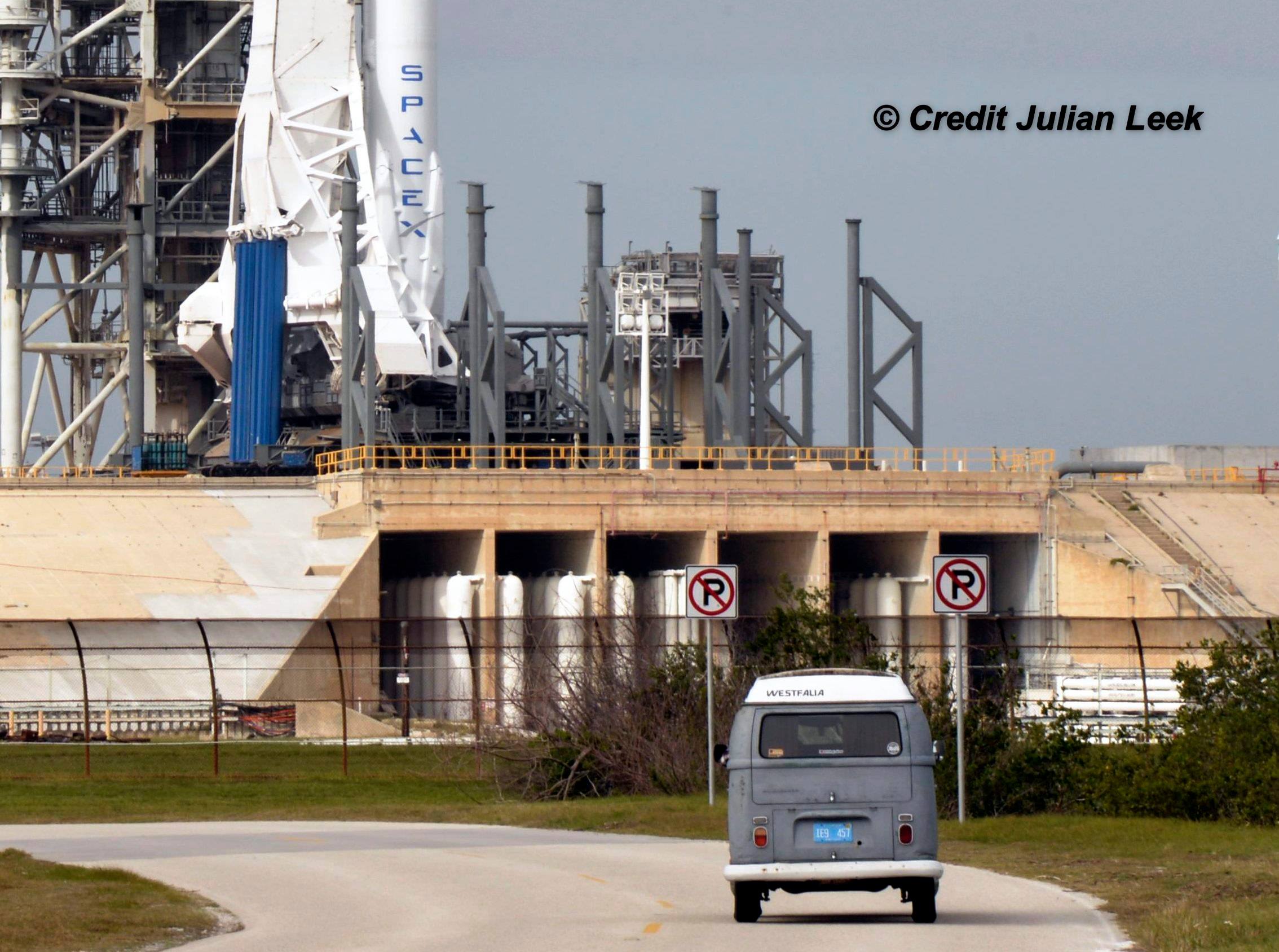
On Friday evening the rocket was lowered to the horizontal position on the transporter erector on pad 39A. It will be rolled back to the processing hangar outside the perimeter fence for further engineering evaluation.
Whenever the launch is rescheduled SpaceX will attempt to recover the 16 story tall first stage booster with a soft landing on the ground back at Cape Canaveral Air Force Station. So expect some extremely loud sonic booms to rock the space coast region about eight minutes after liftoff.
Watch for Ken’s continuing onsite coverage of SpaceX Zuma, KoreaSat-5A & SES-11, ULA NROL-52 and NASA and space mission reports direct from the Kennedy Space Center and Cape Canaveral Air Force Station, Florida.
Stay tuned here for Ken’s continuing Earth and Planetary science and human spaceflight news.
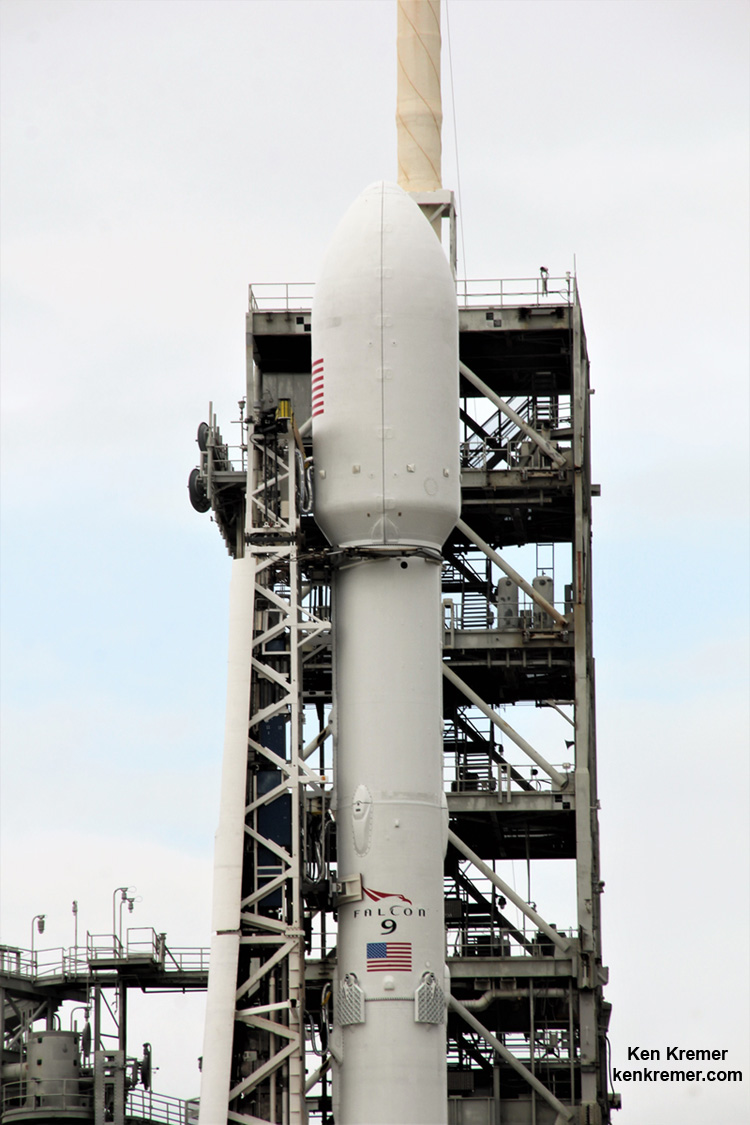
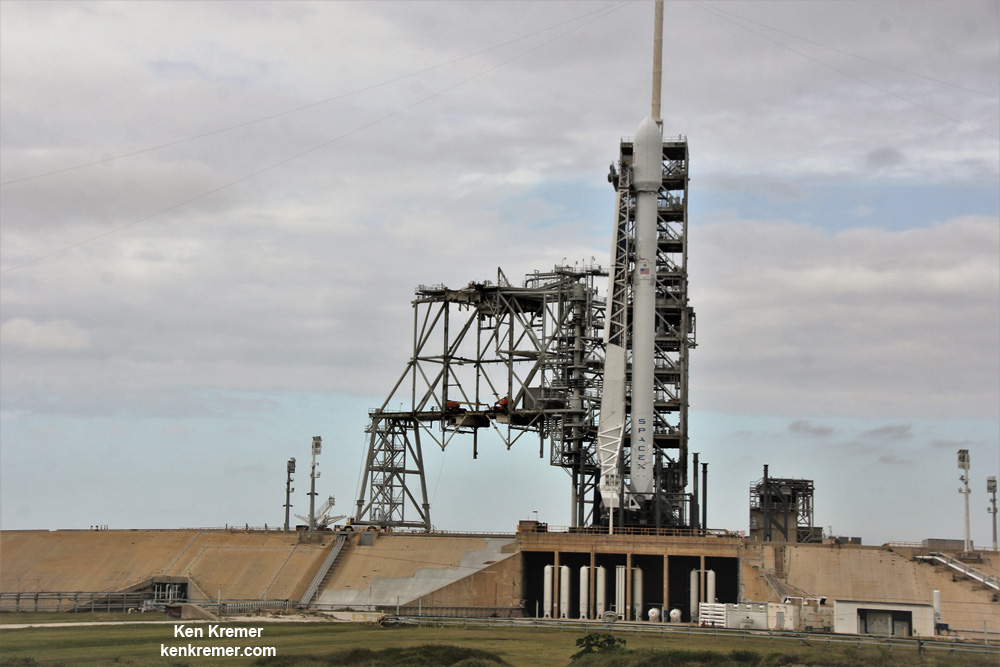
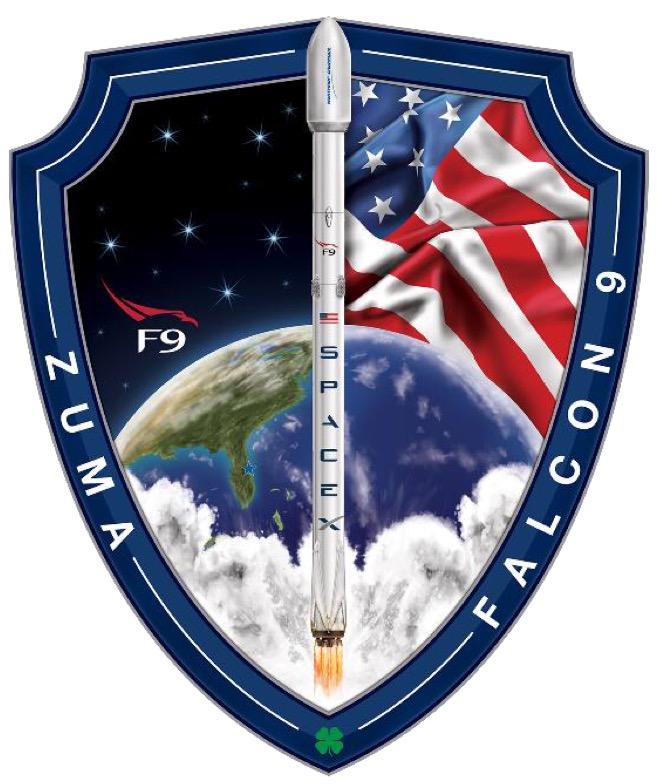
Ownerless Super Secret Zuma Spysat Set for Dark Veiled Dark Night SpaceX Blastoff and Land Landing Nov. 16: Watch Live


KENNEDY SPACE CENTER, FL – The super secret ‘Zuma’ spysat mission claimed by no U.S. government entity – not even the elusive NRO spy agency ! – and whose goals are veiled in virtually complete darkness– is poised for a dark of night blastoff on a SpaceX Falcon rocket Thursday evening, Nov. 16, from the Florida Space Coast. Update: Delayed to Friday 8 PM
An unclassified aspect of the mission codenamed ‘Zuma’ is that SpaceX will also attempt to recover the 16 story tall first stage booster with a soft landing on the ground back at Cape Canaveral Air Force Station. So expect some extremely loud sonic booms to rock the space coast region about eight minutes after liftoff.
Zuma is a total mystery, to the delight of the spymasters.
One of the very few tidbits of information we can absolutely confirm (and not deny) is that the clandestine and ownerless ‘Zuma’ Spysat is now targeted for a nighttime launch on a SpaceX Falcon 9 rocket from seaside Launch Complex 39A at NASA’s Kennedy Space Center in Florida during a lengthy 2 hour window.
We can also confirm that the launch contract was arranged as a commercial enterprise under the auspices of Northrop Grumman Corporation – as a means to significantly slash launch costs for whatever U.S government entity is responsible for Zuma.
That goal is completely in line with SpaceX founder and CEO Elon Musk’s entire company-wide goal in developing the Falcon and Dragon family of rockets and spaceships.
“The U.S. Government assigned Northrop Grumman the responsibility of acquiring launch services for this mission,” Lon Rains, Northrop Grumman Director of Communications, told Universe Today.
“We have procured the Falcon 9 launch service from SpaceX.”
The launch window at pad 39A opens at 8 p.m. EST (0100 GMT). It extends for two full hours until 10 p.m. EST (0300 GMT).
We can further confirm that the launch was postponed a day to Thursday from the originally slated Wednesday night target – ostensibly to deal with last minute ‘mission assurance issues to insure the rocket and payload are ready for a launch upon which SpaceX’s reputation is on the line for future high value national security payloads of the most critical importance to the US governments Defense and Spy agencies
“SpaceX is now targeting Thursday, Nov. 16 for launch of the Zuma mission,” said SpaceX spokesman John Taylor.
“Both Falcon 9 and the payload remain healthy; teams will use the extra day to conduct some additional mission assurance work in advance of launch.”

You can watch the launch live on a SpaceX dedicated webcast starting about 10 minutes prior to the 8 p.m. EDT (0100 GMT) liftoff time.
Watch the SpaceX broadcast live at: SpaceX.com/webcast
The launch window for the newly built booster extends for two hours until it closes at 10 p.m. EDT (0300 GMT).
The weather outlook is rather favorable along the Florida Space Coast with a 90% chance of favorable conditions at launch time according to U.S. Air Force meteorologists with the 45th Space Wing Weather Squadron at Patrick Air Force Base.
The primary concerns on Nov. 16 are only for the Cumulous Cloud Rule.
The odds get even high at greater than 90% favorable for the 24 hour scrub turnaround day Nov 17.
The launch window remains the same on Nov 17 at 8 to 10 p.m.
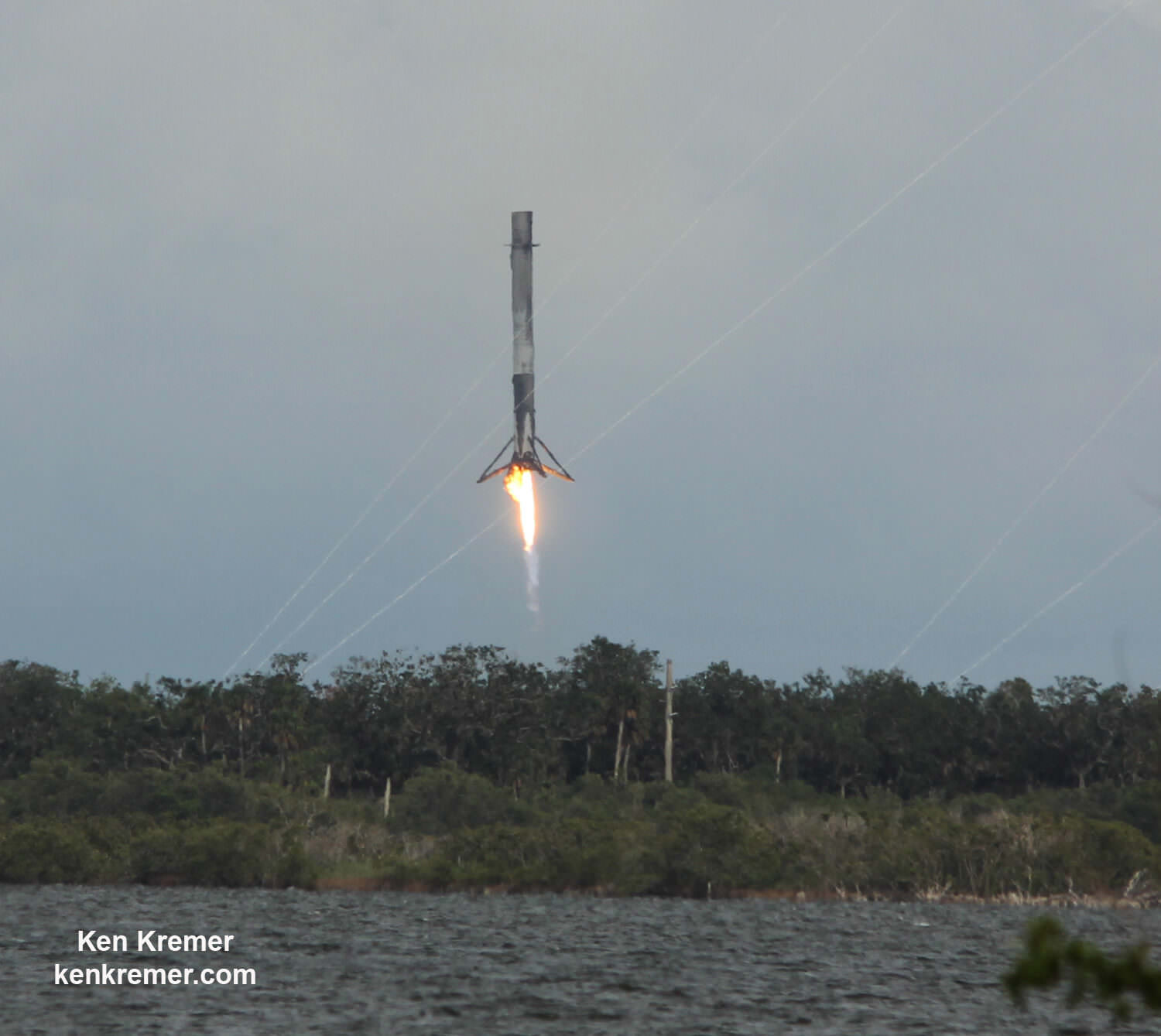
Furthermore the two stage 229-foot-tall (70-meter-tall) Falcon 9 rocket was raised to vertical launch position later today Wednesday afternoon Nov. 15 – so everything seems to be in place for a Thursday evening launch attempt.
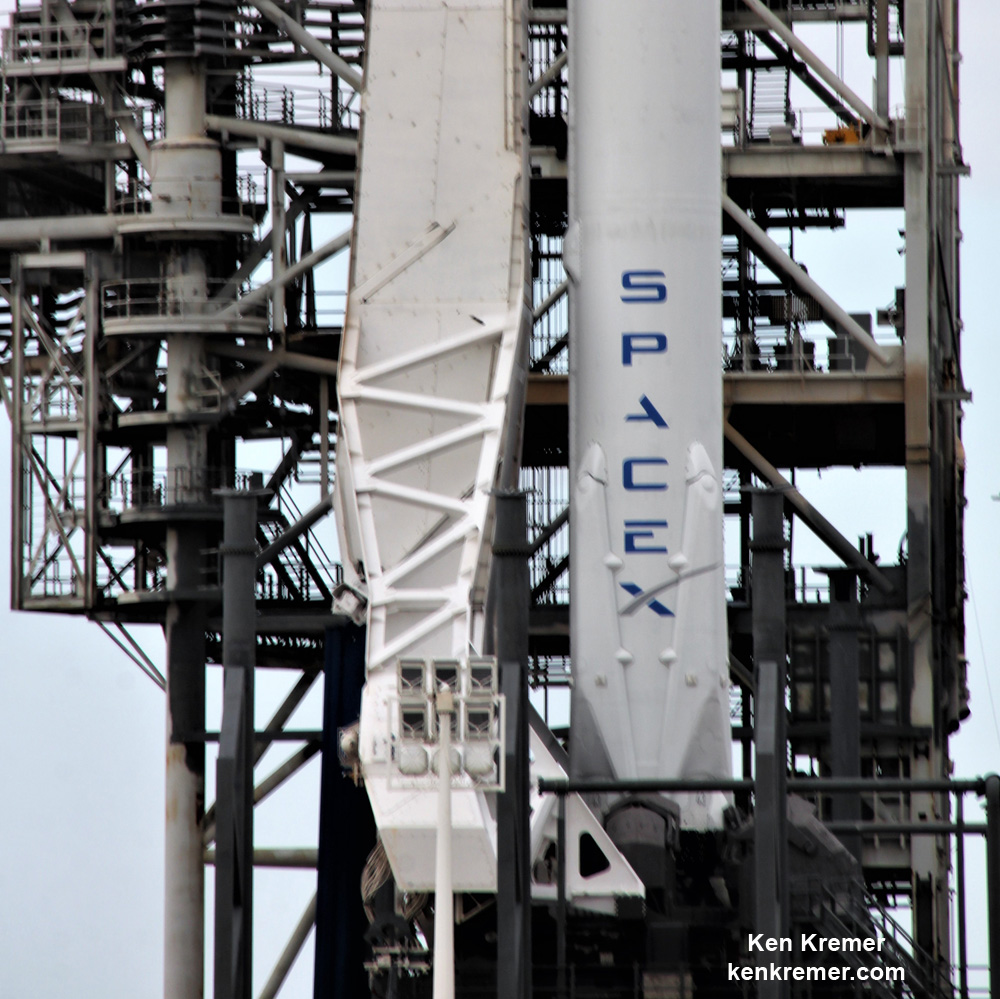
However we don’t know anything about the ‘Zuma’ payloads characteristics and vital statistics – despite the seemingly endless leaks streaming out of Washington these days.
“The Zuma payload is a restricted payload,” Rains told me.
So quite naturally we’re all curious for any nugget of information from which we might draw some reasonable conclusions based on the scientific method of analysis.
The little bits we do know is that the launch services for the ownerless government payload are being procured by Northrop Grumman Corporation under a commercial contract with a stated goal to find a develop a “cost effective approach”
“Northrop Grumman is proud to be a part of the Zuma launch,” Rains added.
“This event represents a cost effective approach to space access for government missions.”
One juicy tidbit we do know is that it is intended for launch to low Earth orbit (LEO).
“It will be launched into Low Earth Orbit,” Rains informed me.
Low Earth Orbit extends upwards to roughly 1200 miles altitude and includes the ISS orbit for example at approx. 250 miles.
“As a company, Northrop Grumman realizes this is a monumental responsibility and we have taken great care to ensure the most affordable and lowest risk scenario for Zuma.”
In addition to launch services Northrop Grumman Corporation may have manufactured the Zuma payload – although that’s not even known.
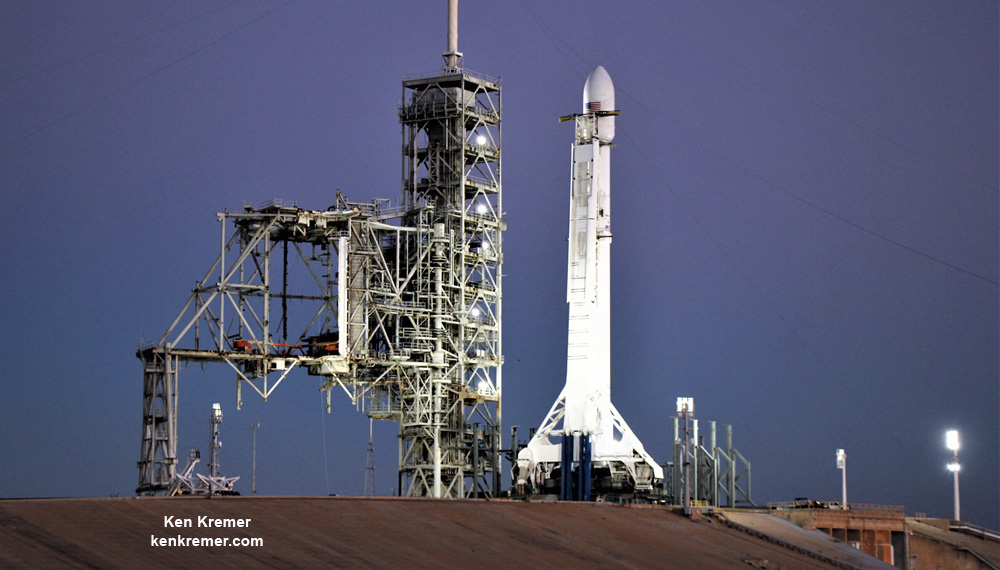
SpaceX has successfully launched a pair of diverse national security payloads this year already with identified customers. Namely the NROL-76 surveillance satellite for the NRO on May 1, 2017 and the OTV-5 military spaceplane for the USAF on Sept. 7.
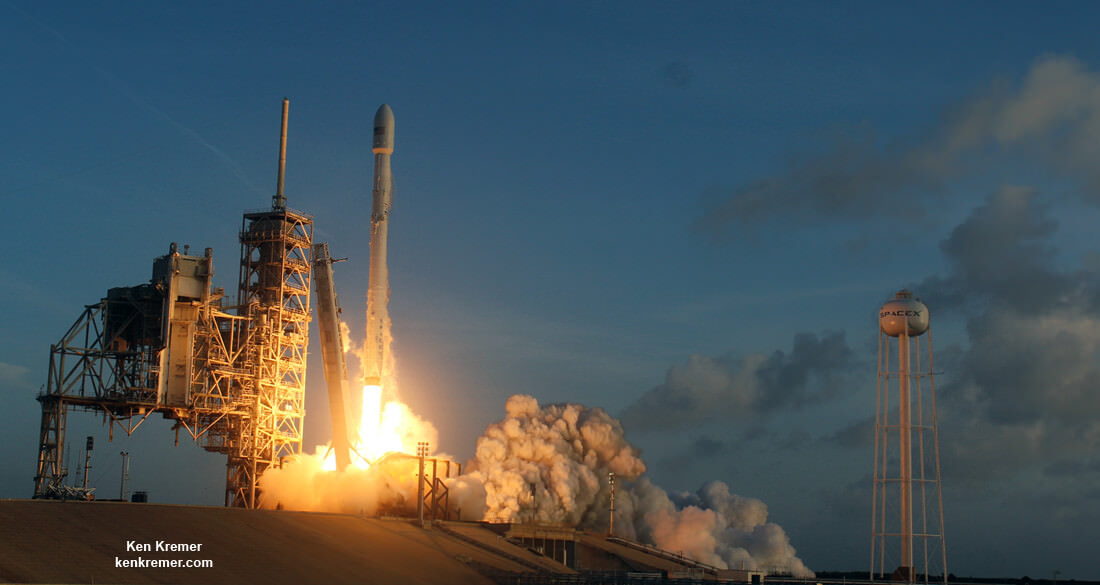
The long launch window should significantly increase the chance of launching Zuma and removing any errant or intentional boaters and flyers from the restricted airspace around the launch pads.
That’s increasingly important these days given that a pair of critical NASA science mission this week and in the past 3 days were scrubbed near T Zero on both US East and West coast launch pads in Virginia for the Orbital ATK Antares rocket and in California for the ULA Delta II rocket.
‘Homeless’ government satellites not even claimed by the NRO are rather rare.
A recent example is Clio, an unclaimed mission from Lockheed Martin.
Clio launched at night on a ULA Atlas V on September 16, 2014 from Space Launch Complex-41 on Cape Canaveral Air Force Station, Fl.
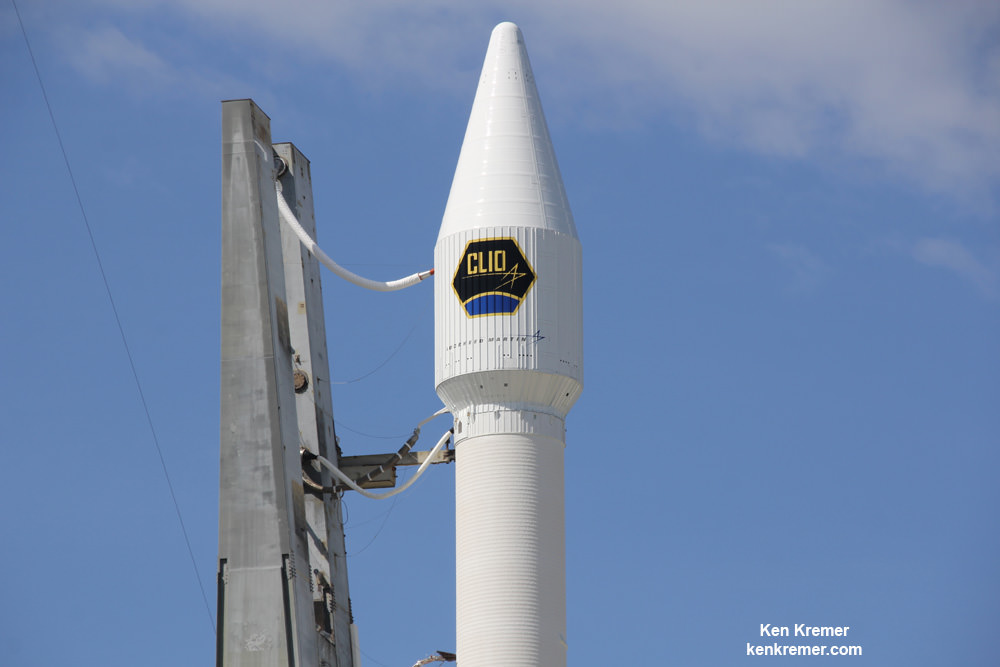
Watch for Ken’s continuing onsite coverage of SpaceX Zuma, KoreaSat-5A & SES-11, ULA NROL-52 and NASA and space mission reports direct from the Kennedy Space Center and Cape Canaveral Air Force Station, Florida.
Stay tuned here for Ken’s continuing Earth and Planetary science and human spaceflight news.
………….
Ken’s upcoming outreach events:
Learn more about the upcoming SpaceX Falcon 9 Zuma launch on Nov 16, 2017, upcoming Falcon Heavy and CRS-13 resupply launches, NASA missions, ULA Atlas & Delta launches, SpySats and more at Ken’s upcoming outreach events at Kennedy Space Center Quality Inn, Titusville, FL:
Nov 17: “SpaceX Falcon 9 Zuma launch, ULA Atlas NRO NROL-52 spysat launch, SpaceX SES-11, CRS-13 resupply launches to the ISS, Intelsat35e, BulgariaSat 1 and NRO Spysat, SLS, Orion, Commercial crew capsules from Boeing and SpaceX , Heroes and Legends at KSCVC, GOES-R weather satellite launch, OSIRIS-Rex, Juno at Jupiter, InSight Mars lander, SpaceX and Orbital ATK cargo missions to the ISS, ULA Delta 4 Heavy spy satellite, Curiosity and Opportunity explore Mars, Pluto and more,” Kennedy Space Center Quality Inn, Titusville, FL, evenings
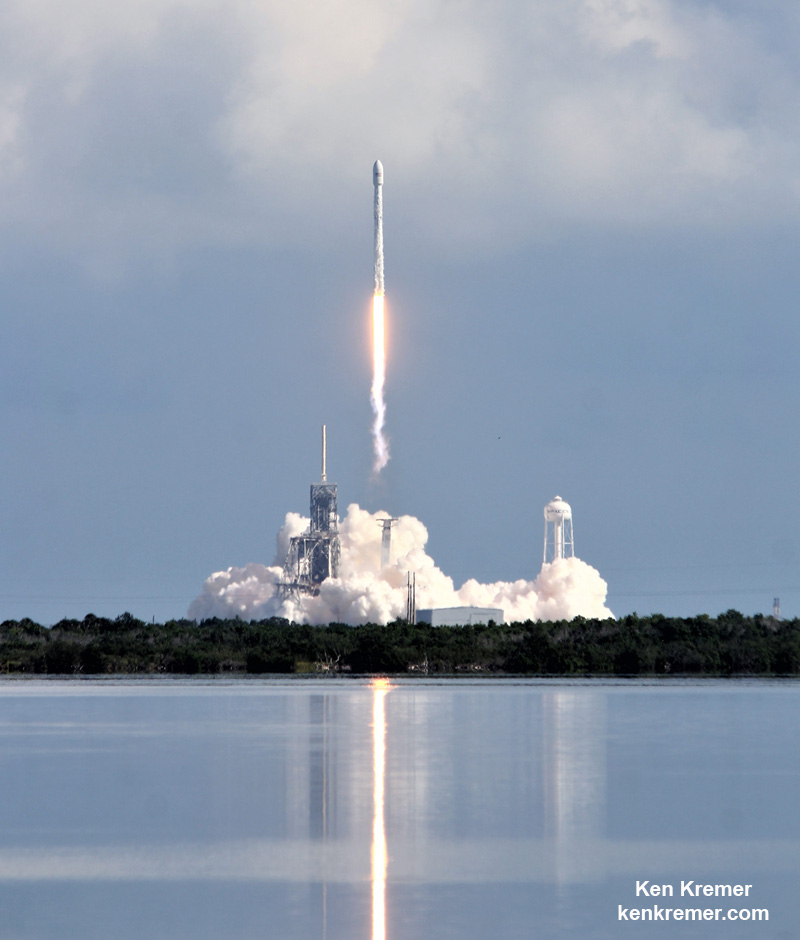

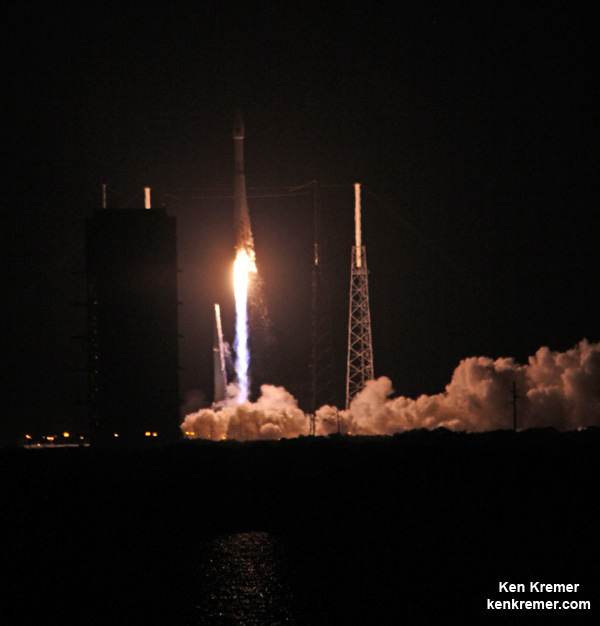
Despite Merlin Engine Testing Anomaly SpaceX Forges Ahead With Ambitious Year End Launch Schedule Commencing Nov. 15
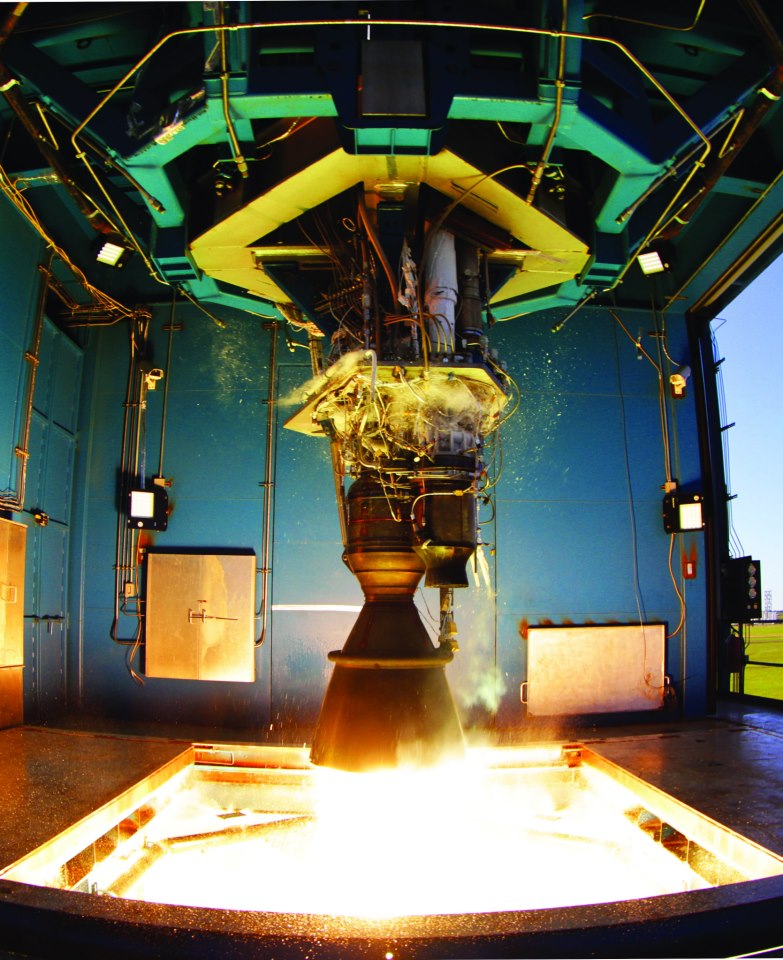

KENNEDY SPACE CENTER, FL – Despite suffering a significant engine testing “anomaly” and fire during test protocols with a Merlin engine that powers both stages of SpaceX’s Falcon 9 rocket, the Elon Musk founded company is forging ahead with an ambitious year end launch schedule that commences this week with blastoff of the secretive Zuma mission on Wednesday evening, Nov. 15. Clearly Musk & Co. feel it is safe to proceed.
While preparing to conduct a test firing of the most advanced Merlin engine of the type that will launch astronauts to the International Space Station (ISS) as soon as next year, something sparked the outbreak of a fire in a test bay earlier this month on a SpaceX engine test stand at their rocket development facility in McGregor, Texas, SpaceX spokesman John Taylor confirmed to Universe Today.
The resulting fire in a McGregor, Texas test bay apparently did not involve an engine explosion as technicians were getting ready to conduct an actual hot fire test. The fire may have occurred as a result of a leak while setting the Merlin engine up on a test stand during pre-test procudures. Details have not been released.
“We do not expect this to have any impact on our launch cadence,” SpaceX spokesman John Taylor told Universe Today.
“SpaceX is committed to our current manifest.”
Since the fire involved the most advanced Block 5 version of the Merlin rather than the currently used Block 4 version, SpaceX engineers and management decided they can safely and responsibly move forward with the upcoming jam packed schedule of Falcon 9 and Falcon Heavy launches, while simultaneously continuing the anomaly investigation.
2017 has been a banner year thus far for SpaceX involving 16 missions to date that ties a ULA record established in 2009.
The most recent launch took place of Oct. 30 delivering KoreaSat-5A to its intended orbit – along with a magnificent soft landing and recovery of the first stage booster on an oceangoing platform that floated ‘back in town’ days later.
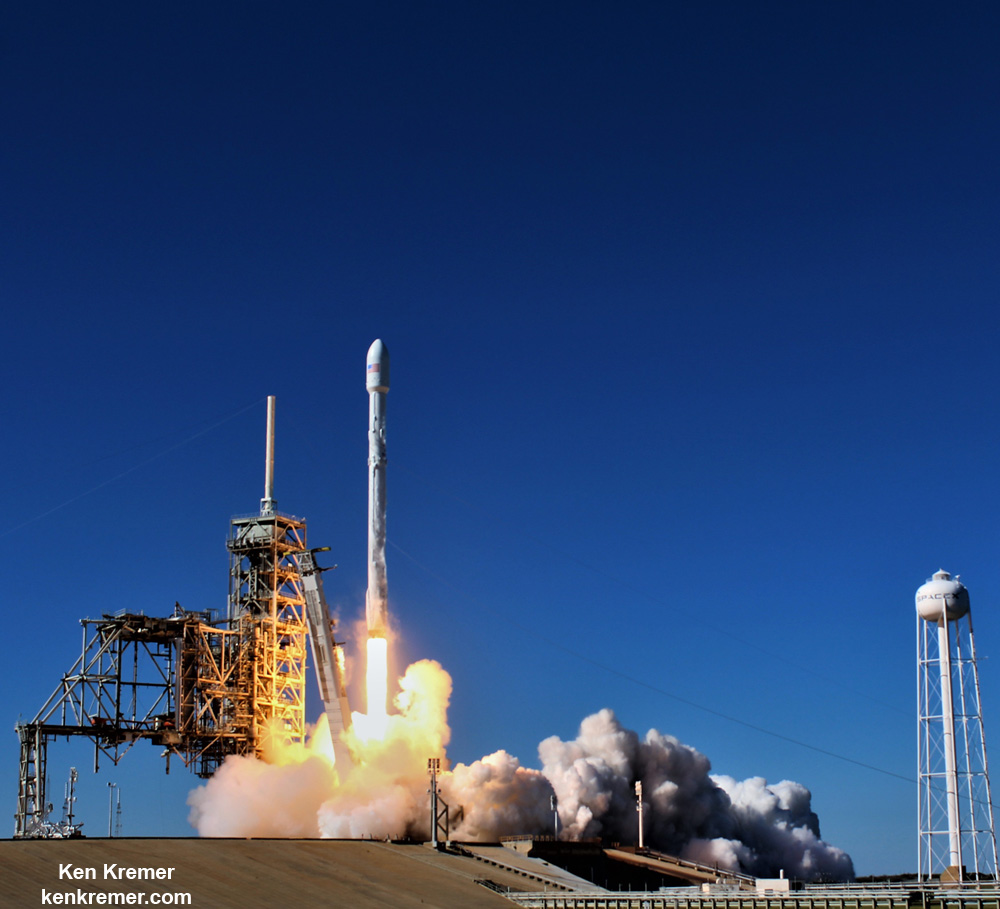
The fire took place on Nov. 4, as first reported by the Washington Post on Nov. 9.
“On November 4, SpaceX experienced an anomaly during a Qualification test set up of a Merlin engine at our rocket development facility in McGregor, Texas,” SpaceX spokesman Taylor told me.
With a slew of critical launches looming starting tomorrow, Nov. 15, SpaceX had to decide quickly whether to pause or move ahead with their final planned launches of 2017 – numbering at least 4 or more and possibly including the long-awaited and long-delayed mammoth Falcon Heavy. It utilizes 27 Merlin 1D engines in the first stage cores.
SpaceX has decided to move ‘Full Speed Ahead’ – after an initial review of the fire incident which is still ongoing.
Seemingly, the fire happened during the set up period for the Merlin engine before the actual qualification engine test had begun. A leak may have occurred around the test stand and caused the fire to brake out.
Although 2017 has been a great year, SpaceX has suffered two catastrophic rocket accidents in 2015 and 2016 as a result of unrelated failures traced to the second stage which slowed down the launch pace as engineers raced to identify and rectify the root causes.
Engineers were conducting a pre-test operation when the test bay fire broke out. It may take a few weeks or more to repair the test stand and resume hot fire testing.
SpaceX has notified customers such as NASA, the FAA and the USAF about the incident – for which SpaceX plans a Dragon cargo resupply mission to the ISS launching as soon as Dec. 4 from Cape Canaveral Air Force Station, FL.
“We are now conducting a thorough and fully transparent investigation of the root cause.”
Fortunately there were no injuries to any personal.
“No one was injured and all safety protocols were followed during the time of this incident,” Taylor explained.
The Merlin engine about to be tested involved the most advanced type known as the Block 5 version that will be used to propel astronauts to orbit inside the SpaceX Crew Dragon.
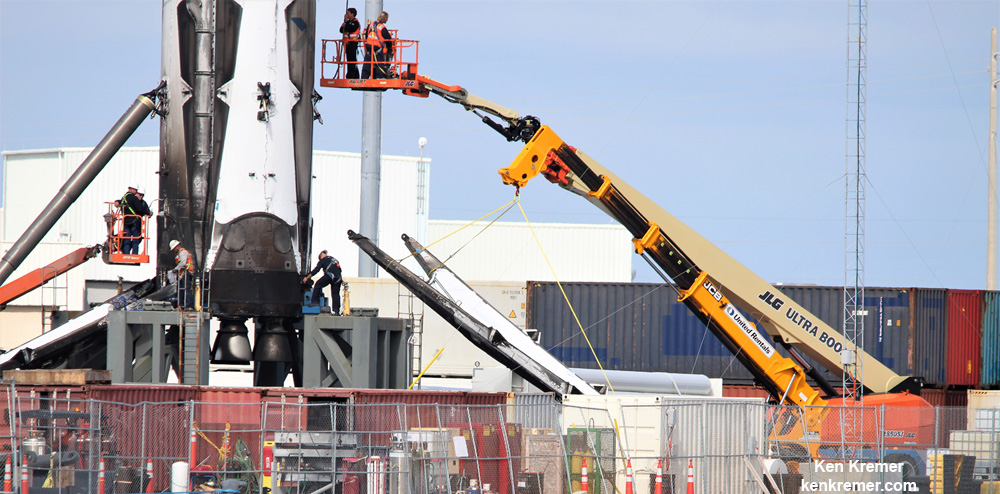
The Falcon 9 is currently powered by 9 Merlin 1D engines of the Block 4 version.
Altogether they generate a combined 1.7 million pounds of liftoff thrust.
SpaceX can continue launches with the less advanced Merlin 1D version because testing of Block 4 is still happening.
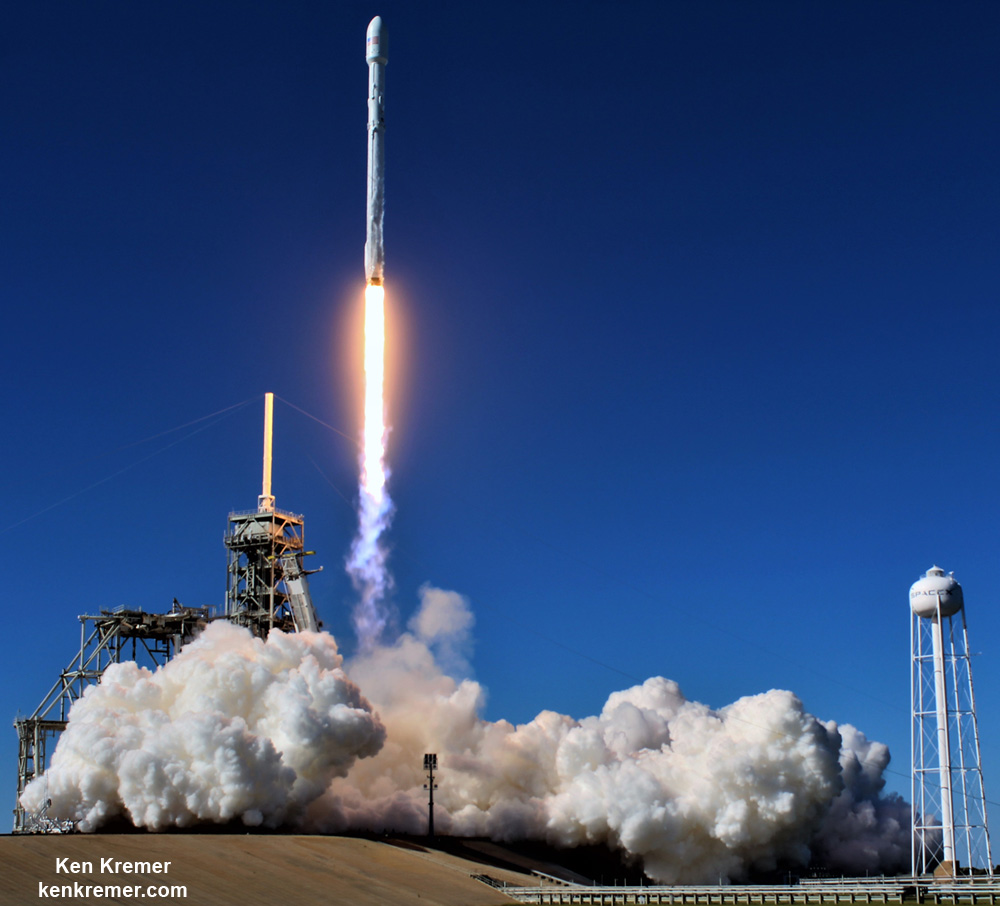
Meanwhile launch preparations are in full swing for Wednesday’s nighttime blastoff of the mysterious Zuma mission for the U.S. government at 8 p.m. EST on Nov. 15 from pad 39A on NASA’s Kennedy Space Center.

Watch for Ken’s continuing onsite coverage of SpaceX Zuma, KoreaSat-5A & SES-11, ULA NROL-52 and NASA and space mission reports direct from the Kennedy Space Center and Cape Canaveral Air Force Station, Florida.
Stay tuned here for Ken’s continuing Earth and Planetary science and human spaceflight news.
………….
Learn more about the upcoming SpaceX Falcon 9 Zuma launch on Nov 15, 2017, upcoming Falcon Heavy and CRS-13 resupply launches, NASA missions, ULA Atlas & Delta launches, SpySats and more at Ken’s upcoming outreach events at Kennedy Space Center Quality Inn, Titusville, FL:
Nov 14, 16: “SpaceX Falcon 9 Zuma launch, ULA Atlas NRO NROL-52 spysat launch, SpaceX SES-11, CRS-13 resupply launches to the ISS, Intelsat35e, BulgariaSat 1 and NRO Spysat, SLS, Orion, Commercial crew capsules from Boeing and SpaceX , Heroes and Legends at KSCVC, GOES-R weather satellite launch, OSIRIS-Rex, Juno at Jupiter, InSight Mars lander, SpaceX and Orbital ATK cargo missions to the ISS, ULA Delta 4 Heavy spy satellite, Curiosity and Opportunity explore Mars, Pluto and more,” Kennedy Space Center Quality Inn, Titusville, FL, evenings
